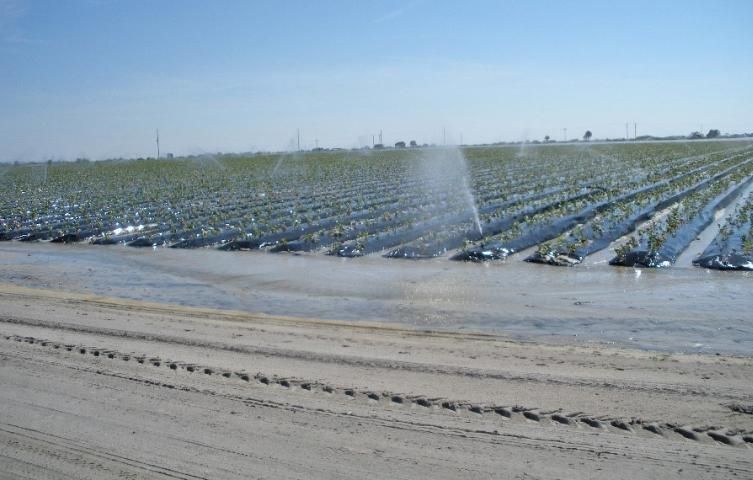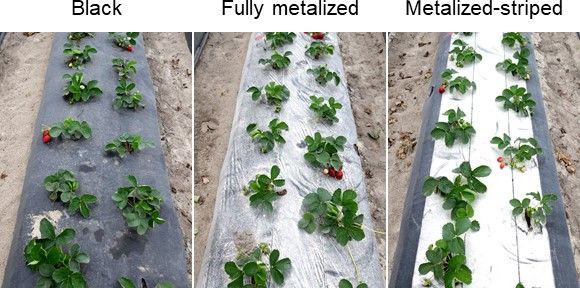Florida is the second-largest strawberry-producing state in the United States, with an annual farm gate value of about $337 million with 9,400 acres planted in 2017 (FDACS 2020). Planting occurs from late September through late October, and high air temperatures pose significant challenges to the survival of the transplants and, thus, yield and fruit quality. Typically, a large volume of irrigation water is needed to ensure proper strawberry plant establishment. Water conservation is desirable, because overconsumption has allegedly caused reoccurring drops in the Florida aquifer, increasing the number of sinkholes and dry wells in the Plant City area. To address these challenges, this Extension publication provides research-based recommendations on transplant establishment methods for strawberry growers in Florida.
Sprinkler Irrigation
Bare-root transplants are the primary transplant type for commercial strawberry growers in Florida. In other production regions, bare-root transplants have no leaves, because they are removed during nursery harvest. However, bare-root transplants for Florida typically have 3–5 functional leaves to promote higher early yields. Transplants for Florida are produced in nurseries in temperate regions, primarily the Appalachian Mountains, Canada, and northern California, and typically cost $0.154–0.169 per plant. Because these transplants have functional leaves but do not have active root systems, they require sprinkler irrigation during daylight hours for the first 8–12 days after transplanting in order to prevent wilting and desiccation.
Cooling from sprinkler irrigation occurs because of evaporation of the water from plant tissue and plastic mulch, absorbing approximately 15,309 calories per oz, as long as the air vapor pressure is lower than the saturated vapor pressure. This effectively reduces the air temperature around the crown and promotes root and shoot growth. Sprinkler heads are usually spaced 48 × 48 ft apart, averaging 19 sprinkler heads per acre. Each sprinkler head delivers 3.9 to 5 gal/min, resulting in water usage between 355,680 and 456,000 gal/acre in 10 days (Santos, Salame-Donoso, and Whidden 2012; Santos et al. 2012) (Figure 1). This cooling method works well in Florida, where sandy soils allow for rapid drainage of the irrigation water. Another suitable option is the use of microsprinkler systems, which were reported to achieve strawberry bare-root establishment in California (Dara 2015). However, the downside is that conventional sprinkler irrigation or alternative means of frost and freeze protection are still needed in Florida.

Credit: Emmanuel Torres-Quezada, UF/IFAS
Reducing sprinkler irrigation and thus the use of groundwater would be highly desirable (Aurit et al. 2013; Hochmuth et al. 2006; Santos et al. 2012). In addition, sprinkler water spreads water-dispersed pathogens and promotes weed germination in furrows. The following alternative methods could be considered as options to reduce or in some cases eliminate sprinkler irrigation for strawberry transplant establishment.
Plug Transplants
Strawberry plug transplants (plugs) have been evaluated in multiple studies across Florida. Compared to bare-root transplants, plugs are reported to establish in the field more rapidly and sometimes produce higher yields because they have more alive and functional roots at the time of transplanting (Bish et al. 1997; Durner et al. 2002; Hochmuth et al. 2006; Torres-Quezada et al. 2020) (Figure 2). By contrast, initial roots of bare-root transplants are mostly desiccated and have very limited water and nutrient uptake capacity.

Credit: Emmanuel Torres-Quezada, UF/IFAS
The production of plugs occurs in the same nurseries as bare-root transplants. Runners are collected from mother plants, placed in plastic trays in peat-based media or Jiffy plugs under mist irrigation, and grown from 6 to 9 weeks. The extra time and labor required for production results in plugs costing twice as much as bare-root transplants ($0.369–0.379). Hence, the transition from bare-root to strawberry plug transplants represents an increase in cost of about $3,702/acre, assuming a plant density of 17,424 plants/acre. However, plugs typically require 0–2 days of overhead irrigation, resulting in water savings of about 324,672 gal/acre per season.
Producing plugs locally could potentially lower transplant costs, but locally produced plugs are limited by a lack of chilling and a higher pathogen load (Torres-Quezada et al. 2020). For this reason, the early yield of locally produced plugs is lower than that of bare-root and conditioned plugs from temperate regions (Torres-Quezada et al. 2020). Though some growers have experimented with local plug production, it is still not a widely adopted practice in the industry (Figure 3).

Credit: Emmanuel Torres-Quezada, UF/IFAS
Intermittent Irrigation
Intermittent application can be used to decrease the duration of sprinkler irrigation, resulting in water savings ranging from 50% to 75% compared to continuous overhead irrigation during daylight hours. Similar yield has been found for bare-root transplants established with continuous sprinkler irrigation and established with various intervals of (on/off) 5/15, 10/20, 5/10, and 15/15 (Santos, Salame-Donoso, and Whidden 2012). Intervals must be adjusted to humidity and wind speed to prevent wilting of transplant foliage. However, the initial investment required to adjust irrigation systems currently used in strawberry fields must be carefully considered, taking into account intermittent operation of pumping systems, labor, automation, and crop monitoring.
Crop Protectants
Other potential methods for strawberry establishment include crop protectants (Dash et al. 2020; Hernandez-Ochoa and Santos 2013; Santos, Salame-Donoso, and Whidden 2012; Torres-Quezada et al. 2018). Various products can serve as shields by coating the plant tissue and reducing tissue temperatures. Additionally, the temporary change in mulch color with the application of kaolin likely results in cooler soil temperatures and thus less heat stress in the transplants. Kaolin clay has been tested at a rate of 25 lb/acre, with research trials indicating that 6 days of sprinkler irrigation followed by a kaolin clay application on day 7 resulted in similar early and total yields as 10 days of sprinkler irrigation (Santos, Salame-Donoso, and Whidden 2012) (Figure 4). The adoption of this practice would represent water savings of approximately 121,752 gal/acre, although sometimes the application process can be compromised if the field is too wet for the tractor to maneuver. Similar research indicated that applications of aluminum silicate and calcium carbonate on day 7 could allow a reduction in water use without a loss of yield (Hernandez-Ochoa and Santos 2013). Further, the cost of the kaolin clay is less than the cost of diesel fuel to pump water for three extra days. A major downside of this approach is that these products can be washed off plants and raised beds by rain, and thus may require reapplication.

Credit: Emmanuel Torres-Quezada, UF/IFAS
Reflective Plastic Mulch
Reflective plastic mulch includes 100% white (white-on-black), 100% metalized (metalized-on-black), and metalized-striped mulch films (Figure 5). Metalized-striped mulch has a 20" wide aluminum center stripe and black shoulders. Compared to black plastic mulch, these reflective mulch films can reduce soil and mulch surface temperatures by reflecting a greater proportion of incoming solar radiation (Deschamps and Agehara 2019; Deschamps et al. 2019). Reflective mulch films can improve establishment and early fruit production of both bare-root and strawberry plug transplants, particularly when planted before October 10. Field trials at the UF/IFAS Gulf Coast Research and Education Center have shown early-season yield increases of up to 34% with reflective mulch films. Similar yield increases have also been observed in commercial fields. Other beneficial effects of reflective mulch films include total season yield increases, fruit size increases, and reduced incidence of Phytophthora crown rot.

Credit: Shinsuke Agehara, UF/IFAS
Metalized mulch films are not recommended if sprinkler water has high pH above 7.5, because it can fade aluminum coatings. Metalized mulch films are also less flexible than black or white-on-black mulch films, so their installation could be more complicated. If this is of concern, white-on-black mulch is recommended, which should perform better than black mulch and nearly as well as metalized mulch.
Conclusions
Strawberry transplant establishment in Florida consumes nearly 3.9 billion gallons of water between late September and late October every year. Several methods are available to reduce or eliminate the use of irrigation for establishment. However, further research and Extension efforts are needed to optimize these practices for large-scale production and increase grower confidence. Perhaps the most immediately applicable practice is intermittent irrigation, which can reduce water use by nearly 33% without affecting early or total yields or significantly increasing production costs. In addition, recent research on reflective plastics such as white-striped and metalized mulches have shown promising results for reducing heat stress in strawberry plants during the early season in Florida. The combination of reflective plastics and intermittent irrigation could be an effective recipe for improving transplant establishment while reducing water use and increasing yields.
References
Aurit, M. D., R. O. Peterson, and J. I. Blanford. 2013. "A GIS Analysis of the Relationship between Sinkholes, Dry-Well Complaints and Groundwater Pumping for Frost-Freeze Protection of Winter Strawberry Production in Florida." PLoS ONE 8 (1): e53832. https://doi.org/10.1371/journal.pone.0053832
Bish, E. B., D. Cantliffe, G. J. Hochmuth, and C. K. Chandler. 1997. "Development of Containerized Strawberry Transplants for Florida's Winter Production System." In: Proceedings of the III International Strawberry Symposium of the International Society of Horticultural Science. ActaHortic 439 (77): 461–468.
Dara, S. K. 2015. "Conserving Irrigation Water in Strawberries with Micro-sprinklers." Accessed May 19, 2020. https://ucanr.edu/blogs/strawberries-vegetables/index.cfm?start=40
Dash, P. K., C. A. Chase, S. Agehara, and L. Zotarelli. 2020. "Heat Stress Mitigation Effects of Kaolin and s-abscisic Acid during the Establishment of Strawberry Plug Transplants." Scientia Horticulturae 267 (1): 1–10.
Deschamps, S. S., and S. Agehara. 2019. "Metalized-Striped Plastic Mulch Reduces Root-Zone Temperatures during Establishment and Increases Early Season Yields of Annual Winter Strawberry." HortScience 54:110–116.
Deschamps, S. S., V. M. Whitaker, and S. Agehara. 2019. "White-Striped Plastic Mulch Reduces Root-Zone Temperatures during Establishment and Increases Early Season Yields of Annual Winter Strawberry." Scientia Horticulturae 243: 602–608.
Durner, E. F., E. B. Poling, and J. L. Maas. 2002. "Recent Advances in Strawberry Plug Transplant Technology." HortTechnology 12 (4): 545–550.
Florida Department of Agriculture and Consumer Services (FDACS). 2020. "Florida Agriculture Overview and Statistics." Accessed June 2, 2020. https://www.fdacs.gov/Agriculture-Industry/Florida-Agriculture-Overview-and-Statistics
Hernández-Ochoa, I. M., and B. M. Santos. 2013. "Comparison of Foliar and Root-Dip Crop Protectants for Strawberry Transplant Establishment." Proceedings of the Florida State Horticultural Society 126:142–144. Sarasota, Florida.
Hochmuth, G., D. Cantliffe, C. Chandler, C. Stanley, E. Bish, E. Waldo, D. Legard, and J. Duval. 2006. "Fruiting Responses Economics of Containerized and Bare-Root Strawberry Transplants Established with Different Irrigation Methods." HortTechnology 16 (2): 205–210.
Santos, B. M., T. P. Salame-Donoso, and A. J. Whidden. 2012. "Reducing Sprinkler Irrigation Volumes for Strawberry Transplants Establishment in Florida." HortTechnology 22 (2): 224–227.
Santos, B. M., C. D. Stanly, A. J. Whidden, T. P. Salame-Donoso, V. M. Whitaker, I. M. Hernández-Ochoa, P. Huang, and E. A. Torres-Quezada. 2012. "Improved Sustainability through Novel Water Management Strategies for Strawberry Transplant Establishment in Florida, United States." Agronomy 2 (4): 312–320.
Torres-Quezada, E. A., L. Zotarelli, V. W. Whitaker, R. L. Darnell, K. Morgan, and B. M. Santos. 2018. "Planting Dates and Transplant Establishment Methods on Early-Yield Strawberry in West-Central Florida." HortTechnology 28 (5): 615–623.
Torres-Quezada, E. A., L. Zotarelli, V. W. Whitaker, R. L. Darnell, K. Morgan, and B. M. Santos. 2020. "Production Techniques for Strawberry Plugs in West-Central Florida." HortTechnology 30 (2): 238–247. https://doi.org/10.21273/HORTTECH04529-19